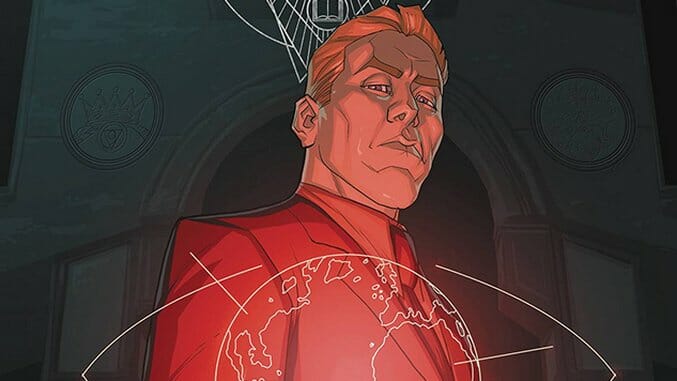Cryptocracy‘s Van Jensen on Secret Societies, Filmmaking and Creating a “Grand Unified Conspiracy Theory”

Conspiracy theories, secret societies and the paranormal have long fueled compelling fiction. Narratives ranging from The X-Files to The Da Vinci Code and Orphan Black have used these elements to draw in audiences and keep them guessing what’s real and what’s been manufactured to deceive the masses. Some stories have even taken a more metafictional approach: Umberto Eco’s novel Foucault’s Pendulum focuses on an ostensibly false conspiracy spanning centuries that slowly edges into reality.
New series Cryptocracy from writer Van Jensen and artist Pete Woods takes an all-encompassing approach to this history, including underground organizations, cryptids and mind-controlling aliens in its layered narrative tapestry. The first issue, out today from Dark Horse, follows Grahame, an agent of an organization that regulates this Pandora’s box of secrets, as he faces threats from all directions. The approach is both wonderfully over-the-top and emotionally grounded, forming a brand new fiction rife with ambition and secrets. Paste emailed with Jensen about the new series, his recent foray into filmmaking and more.![]()
Paste: What was the first conspiracy theory or unexplained phenomenon that you found compelling?
Van Jensen: Hm. I remember being really interested in the idea of aliens, and of the mystery of Area 51 when I was pretty young—maybe eight or so. I started reading Bradbury’s Martian Chronicles around then, and so the concept of space travel and the great unknown of the universe seemed both fascinating and terrifying.
Paste: Is there a direct line from there to the kind of world-defining conspiracy that you showcase in your new series?
Jensen: Yes and no. I was always drawn to things that are unknown. So much of the world is explained and quantified, and I sought out whatever remained opaque or unseen. That’s where your imagination can roam. But it was definitely later that I started to read into the Illuminati and Freemasons and groups like that, these massive, world-spanning entities. I read The Illuminatus! Trilogy early in college, and that pushed me into a pretty serious bit of reading on all those supposed shadow governments.

Cryptocracy #1 Interior Art by Pete Woods
Paste: The history of the conspiracies in Cryptocracy goes back centuries, and encompasses everything from secret societies to aliens to cryptids. How did you decide what to include and what to leave out?
Jensen: Part of the fun of it was treating this like a grand unified conspiracy theory, finding ways to make all these wildly disparate concepts work as a whole. Pete Woods and I sat down on the front end and talked conspiracies and came up with a list of ones that we had to include. I did a ton of research and basically pulled in as much as I could without bogging down the story. Because the story is what really matters, as fun as all these details are.
Paste: There’s a speech in the first issue where one character criticizes violent extremism. Where do you find the ideal balance between nods to real-world politics and the more over-the-top aspects of the series?
-

-

-

-

-

-

-

-

-

-

-

-

-

-

-

-

-

-

-

-

-

-

-

-

-

-

-

-

-

-

-

-

-

-

-

-

-

-

-

-











































